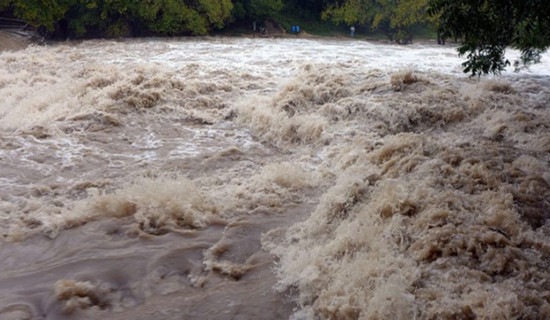- Monday, 15 December 2025
Elephants In Bardiya
Rajesh Dhungana
During the rainy season, one can see herds of elephants in places like Dalla, Karnali Coastal Area, Karnali Corridor, Babai Area, and Geruwa in the Bardiya region. Rajesh Lamsal, Assistant Conservation Officer of Bardiya National Wildlife Refuge, said that even though Nepal's elephants cross the Indian border, 50 to 60 herds of elephants come to eat grass during this season, as the grasses look green in mixed, thin and evergreen forests, thick grasses, jungles and grasslands. Tells. It is estimated that Bardiya National Park shelters some 120 wild elephants and 60 elephants.
The Asian elephant (Elephas Maximus) is the only living species of the genus Elephas and it ranges across the Indian subcontinent and Southeast Asia, from India and Nepal in the west to Borneo in the south. Three subspecies of elephants are recognised. The Sri Lankan elephant (Elephas maximus), the Indian elephant (Elephas maximus indicus), and the Sumatran elephant (Elephas maximus sumatranus) are classified as Endangered on the IUCN Red List.
Decreasing Number
Because the population of these elephants has decreased by 50 per cent in the last three generations and has been listed in the CITES appendix, which protects the international trade of these elephants. Among the 13 elephant range states in Asia, Nepal has an elephant range of 109 to 1,422 individuals (according to research) covering about 2,500 square kilometres.
Nepal Asian elephants are spread across the Terai region of Nepal and it is estimated that there are elephants in 22 districts of Nepal. Bardiya National Park, Chitwan National Park, Koshi Tappu, Parsa National Park and Shukla Fanta National Park are located here. The current estimated total number of elephants in Nepal is between 255 and 265 (including 150 domestic elephants).
Until 1960s, there were large numbers of elephants in the lower forest areas of Nepal. Within the boundaries of the Bardiya National Park, a marked population increase was recorded from 25 elephants in the early 1990s to a decade later.

From the beginning of the 20th century until the 1970s, the number of domestic elephants in Nepal was continuously decreasing, but in the last 25 to 30 years, the number has increased. This reverse trend is partly due to the availability of jobs in the growing ecotourism industry. Nepal's elephant population is stable and has long-term viability.
The number of elephants in the wild has doubled since 2008. There are two species of elephants in the world. The first Asian elephant and the second African elephant. The Asian elephant is popular in every community and is the largest land mammal in Asia.
The elephant has a body length of 5.5 to 6.5 metres and a shoulder height of 3 metres. Its weight ranges from about 2,000 to 5,500 kg. This elephant has no sweat glands on its skin.
These elephants lower their body temperature by shaking their ears. The hearing power of an elephant is very sharp. It can hear sounds higher than human ability (8 to 12000 Hz). A male elephant has a long tusk protruding from the base of its trunk. Although the female Asian elephant does not have such a protruding tusk, it does have a small task that does not extend beyond the trunk. No male elephant has such a beard and they are called (Makhana).
An elephant's skin is usually very tough, about an inch thick on the back and head. The skin of the mouth, anus and inner part of the ear is very thin. Elephants usually have brown skin, but African elephants appear brown or red when exposed to coloured soil. Asian elephants have some areas of depigmentation, especially on the forehead and ears and surrounding areas. Calves have brown or red hair, especially on the head and back.
As elephants mature, their hair becomes darker and sparser, but denser concentrations of hair and bristles remain near the tail, as well as on the trunk, genitals, and areas around the eyes and ears. Generally, an Asian elephant's skin is covered with more hair than its African counterpart.
Their hair is considered for thermoregulation. They help to lose heat in hot environments. Elephants use mud as sunscreen. It protects the skin from UV rays.
Apart from Nepal, elephants are found in natural habitats in Bangladesh, Bhutan, Cambodia, China, India, Indonesia, Laos, Malaysia, Myanmar, Sri Lanka, Thailand and Vietnam.
Elephants prefer to live in moist and dry, broad-leaved forests, mostly in tropical and temperate regions. It changes its habitat according to the season, during the dry season it lives near river banks and water. Elephants change their feeding habits according to the season. That is why elephants continue to cross the Nepal-India border around the Bardiya National Park.
An elephant is an amazing animal for its weight. It can continuously feed on grass, fruits, plants, leaves, tree bark etc. for 16 to 18 hours. It can eat from 149 to 170 kg each day. While an elephant can drink an estimated 100 litres of water at a time, it needs an estimated 225 litres of water a day.
Elephants use their trunks to eat, breathe, bathe, drink water, smell, clean dust, play and interact with others. Elephants can store up to 5 litres of water in their trunks and can even locate water sources from far away.
An elephant is an animal whose age is divided into 4 parts. Those below one year are called (Chhawa), above one year (partial adult), above five years (sub-adult) and fifteen years (adult). Depending on the availability of resources, the reproductive maturity of an elephant is between 9 and 12 years and its gestation period is 18 to 22 months. Males that are free from fertility are called (masts). Males are capable of intercourse at any time, but adult females prefer masts. An elephant gives birth to only one calf at a time and has a natural life span of 60 to 70 years.
Social Behaviour
The social behaviour of elephants is amazing. A female elephant is always the leader in a herd of elephants. Herds consist of groups of at least 6 to 12 elephants. After breeding, the male leaves his mother's group and lives alone for the rest of his life. Adult males only mate with females during the breeding season. Elephants are social and intelligent animals with sophisticated habits. It has empathy and the ability to learn, so it can use objects to solve complex problems.
There are many examples of it breaking down the electric barriers made to stop the wild elephants with the help of sticks and sticks. The range of herds is determined by habitat, food and water availability.
According to the National Wildlife and Wildlife Protection Act 2029, the elephant has been placed on the list of protected animals of the Government of Nepal. There is a provision that those who harm or kill elephants and trade in their poultices can be fined from 50,000 to 100,000 rupees or imprisoned for 5 to 15 years or both. (Photos by Wildlife Photographer Manju Mahatara (Anjel Moha)
(Dhungana is a photojournalist, specialising in wildlife photography)
How did you feel after reading this news?















